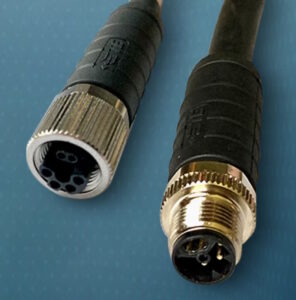The IEEE 802.3 single-pair Ethernet (SPE) standards include multidrop and daisy-chain architectures that support applications like automotive, industrial, and smart buildings. In addition, a range of SPE connector standards are available with several environmental classifications and ratings based on mechanical, ingress, climatic/chemical, and electromagnetic (M.I.C.E) attributes.
Automotive systems are a key target for SPE deployment. Automobiles have a range of applications that can require data rates of 1 Gbps and higher. However, high-data-rate applications like video, Lidar, and radar are not the target of automotive SPE. IEEE 802.3ch, the Multi-Gigabit Ethernet standard, which can operate at 2.5Gbps, 5Gbps, and 10Gbps, serves the needs of high-data-rate applications.
Body-domain functions in zonal architectures, on the other hand, typically need 10 Mbps or less. They are the targets for IEEE 802.cg 10BASE-T1S. It supports multidrop with a reach of up to 25 m. The standard specifies support for at least 8 nodes, but more are possible. It can deliver power over data lines (PoDL) to connect and power sensors, microphones, actuators, and other devices (Figure 1).

10BASE-T1S leverages the common Ethernet control stack, simplifying integration into automotive Ethernet-based networks. It supports Scalable service-oriented MiddlewarE over IP (SOME/IP), an automotive middleware solution for control messages. SOME/IP is scalable and can be used with a wide range of automotive devices, including cameras, infotainment systems, AUTomotive Open System Architecture (AUTOSAR) devices, and so on. It can also be used to replace media-oriented systems transport (MOST) and controller area network (CAN) networks and support the development of software-defined vehicles.
Industrial systems and smart buildings
10BASE-T1L (T1L) supports distances up to 1 km using SPE. It does not support multidrop technology but can be implemented using a daisy-chain architecture and can be installed as a ring network for greater resilience and reliability. A newer standard, 10BASE-T1M (T1M), supports multidrop deployments.
T1L and T1M can be used for small devices like sensors or actuators that are solely powered by PoDL or to send control signals for larger devices like motors, solenoids, lighting fixtures, access control systems, and heating ventilation and air conditioning (HVAC) units that require a dedicated AC or DC power source (Figure 2).

Ethernet advanced physical layer (APL) is a T1L enhancement optimized for use in process control applications. It can support a variety of higher-level protocols, such as EtherNet/IP, HART-IP, OPC-UA, PROFINET, and so on.
T1L also supports 2-wire intrinsically safe Ethernet (2-WISE). It offers the choice of two amplitude modes. In non-intrinsically safe areas, T1L can use 2.4 V peak-to-peak (pk-pk) to deliver up to 60 W using cables up to 1 km long. In intrinsically safe areas, T1L can use 1 V pk-pk to deliver a maximum of 500 mW over up to 200 m and be deployed in explosion-protected environments.
Connector standards
The M.I.C.E attributes provide a method of categorizing the environmental classes required for each of the industrial areas and is rated as 1 = low, 2 = medium, and 3 = high. SPE connectors are available based on three M.I.C.E. categories: M1I1C1E1 for applications in typical office environments, M2I2C2E2 for use in light industrial environments and control cabinets, and M3I3C3E3 devices in harsh industrial environments.
IEC 93171 is the basic standard. There are additional standards developed by specific manufacturers, including:
- IEC 63171-1 from CommScope based on LC interlock for M1I1C1E1 applications.
- IEC 63171-2 IP20-rated connectors from Reichle & De-Massari for M1I1C1E1 applications.
- IEC 63171-3 from Siemon based on the company’s Tera connectors for M1I1C1E1 applications (withdrawn).
- IEC 63171-4 from BKS for M1I1C1E1 applications.
- IEC 63171-5 IP67-rated connectors from Phoenix Contact are based on the IEC 63171-2 mating face for M2I2C2E2 and M3I3C3E3 applications.
- IEC 63171-6 from HARTING and TE Connectivity for M1I1C1E1, M2I2C2E2, and M3I3C3E3 applications.
- IEC 63171-7: M3I3C3E3 hybrid M12 SPE connectors (data and power) (Figure 3).

Summary
IEEE 802.3 SPE standards include multidrop and daisy-chain architectures that support use cases like automotive, industrial, and smart buildings. In automotive applications, they support zonal architectures and SOME/IP. In industrial systems, T1L can support transmission distances up to 1 km and up to 200 m when deployed in explosion-protected environments. In addition, a range of SPE connector standards are available with several environmental classifications and ratings based on M.I.C.E attributes.
References
10SPE multidrop enhancements, IEEE
Five Reasons 10BASE-T1S Is Boosting Software-Defined Vehicles, Spirent
Ethernet – To the Field, Ethernet APL
Single Pair Ethernet and Ethernet-APL moving ahead, Industrial Ethernet Book
SPE for Field Communication, Single Pair Ethernet System Alliance
What is 10Base-T1S Automotive Ethernet?, Teledyne Lecroy
Why 10BASE-T1S Is the Missing Ethernet Link for Automotive Communications, Analog Devices
Zone architecture, Ethernet drive vehicle of the future, Texas Instruments
Filed Under: Connector Tips




